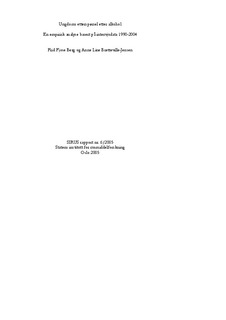| dc.contributor.author | Berg, Frid Fjose | |
| dc.contributor.author | Bretteville-Jensen, Anne Line | |
| dc.date.accessioned | 2015-01-29T13:36:20Z | |
| dc.date.accessioned | 2015-02-11T19:14:55Z | |
| dc.date.available | 2015-01-29T13:36:20Z | |
| dc.date.available | 2015-02-11T19:14:55Z | |
| dc.date.issued | 2005 | |
| dc.identifier.citation | SIRUS-rapport. 75 p. Statens institutt for rusmiddelforskning, 2005 | |
| dc.identifier.isbn | 82-7171-280-2 | |
| dc.identifier.uri | http://hdl.handle.net/11250/275963 | |
| dc.description | - | |
| dc.description.abstract | I rapporten studeres ungdoms forbruk av alkohol. Forhold som påvirker om og eventuelt hvor mye ungdommer drikker blir analysert. Sammenhengen mellom ungdommers alkoholforbruk og priser, og mellom forbruk og aldersgrenser blir studert spesielt.
Undersøkelsen bygger på svar fra 32 000 ungdommer fra 15 til 20 år samlet inn fra 1990 til 2004. I denne perioden har ikke andelen som noen gang har drukket alkohol endret seg. Debutalderen har også vært stabil på ca 15 år. Alkoholbruken blant ungdom som har drukket har imidlertid økt betydelig. Det samlede konsumet har økt med 50 prosent, fra et gjennomsnitt på 0,18 liter ren alkolhol per måned i 1990 til 0,27 liter ren alkohol i 2004.
Rapporten konkluderer med at både aldersgrensen og avgiftspolitikken ser ut å virke inn på ungdoms alkoholforbruk. Prisen har sannsynligvis større betydning for hvor mye som drikkes enn om ungdom velger å drikker i det hele tatt. Aldersgrensen ser ut til å ha sterkest effekt for kjøp av øl og vin, og der er også for øl at man finner klare effekter av avgiftspolitikken. | |
| dc.description.abstract | Official policy in Norway seeks to restrict the consumption of alcohol, especially by young people. This report looks at youth consumption patterns with regard to beer, wine and spirits. We probe factors affecting the decision to drink over the past month and how much is drunk. We also investigated other aspects of young people’s drinking patterns, such as changes in the proportion claiming to have touched alcohol at some time; whether there was an increase in the number of young people claiming to have been drunk; whether alcopop’s share of young people’s total consumption had grown; dealings with moonshining etc.
There has been little scientific focus on the impact of excise duties on youth drinking patterns either by the Norwegian or indeed international research community. But given that alcohol taxes are considered a prime policy instrument because they directly affect retail prices, we were particularly interested to explore the relationship between the price of alcohol and youth alcohol consumption patterns. We investigated the importance of price changes on young people reporting having drunk in the past month; the extent to which alcohol consumption of those who drink is affected by price changes; we studied drinking patterns in relation to age limits enacted by the authorities on the purchase of different alcoholic beverages. Age limits make it more difficult to obtain alcohol, and represents for potential under-age shoppers an added transaction cost.
The body of the data used in this analysis was collected by SIRUS. Between 1990 and 2004 a total of 32,000 young people (15–20), resident in Norway, were questioned about drugs and drink. The surveys included questions about tobacco, alcohol and drug use, as well as obtaining information on standard variables like sex, age, education, domicile etc.
We found no change in the period covered by this study (1990–2004) in the number of respondents reporting having ever drunk alcohol, but we did discover a change in young people’s drinking preferences. The number reporting having ever drunk beer, wine or spirits fell; we found however high alcopop consumption levels in 2003–04 (the years for which we have data on alcopop), significantly higher in fact than for the other types of drink. The alcohol debut age remained stable over the period (at about fifteen), whether the drink in question was beer, wine or spirits. | |
| dc.language.iso | nob | |
| dc.relation.uri | http://www.sirus.no/filestore/Import_vedlegg/sirusrap.6.05.pdf | |
| dc.title | Ungdoms etterspørsel etter alkohol. En empirisk analyse basert på intervjudata 1990-2004 | |
| dc.title.alternative | Young people’s demand for alcohol. | |
| dc.type | Research report | |
| dc.date.updated | 2015-01-29T13:36:20Z | |
| dc.identifier.cristin | 1062413 | |
